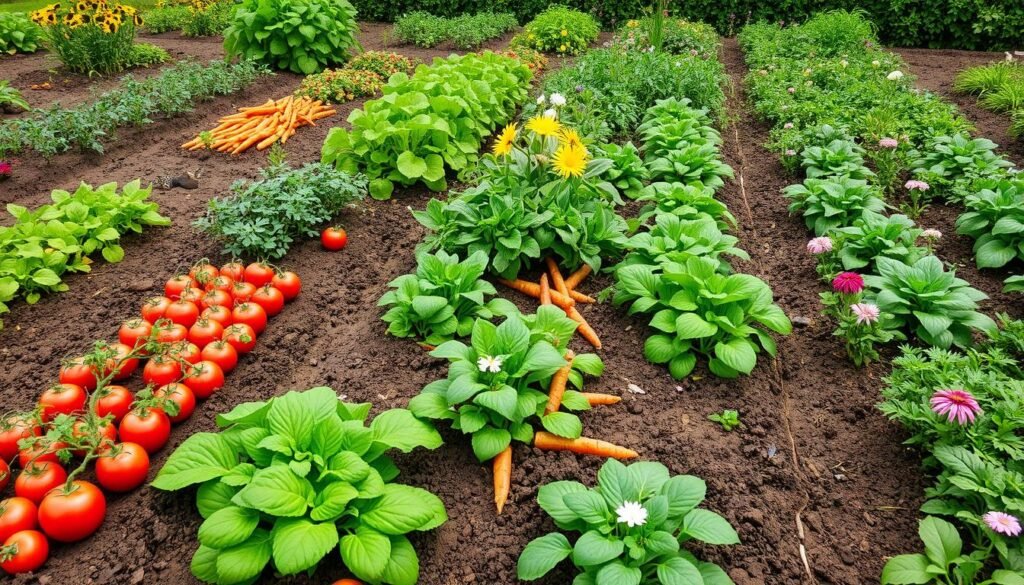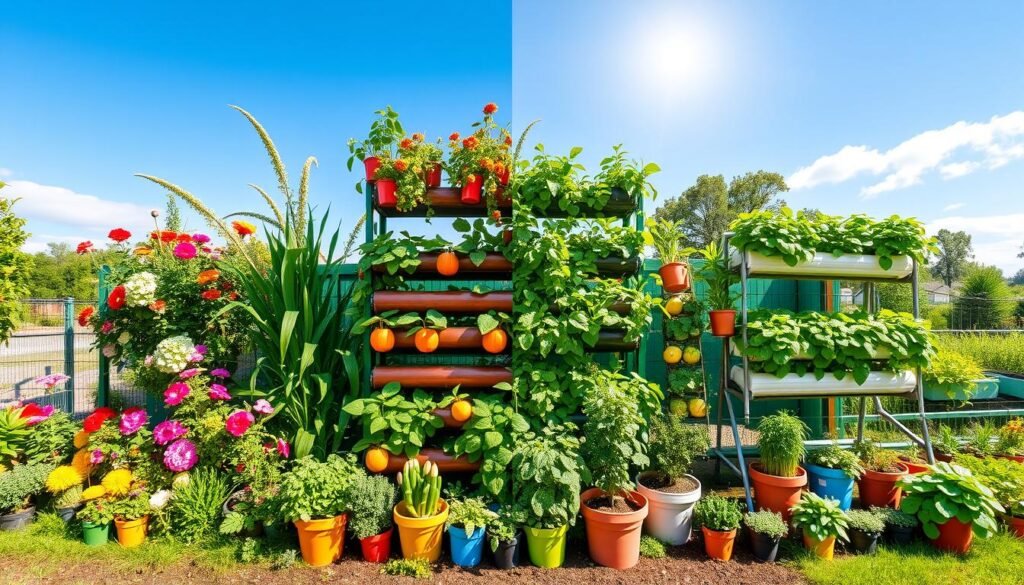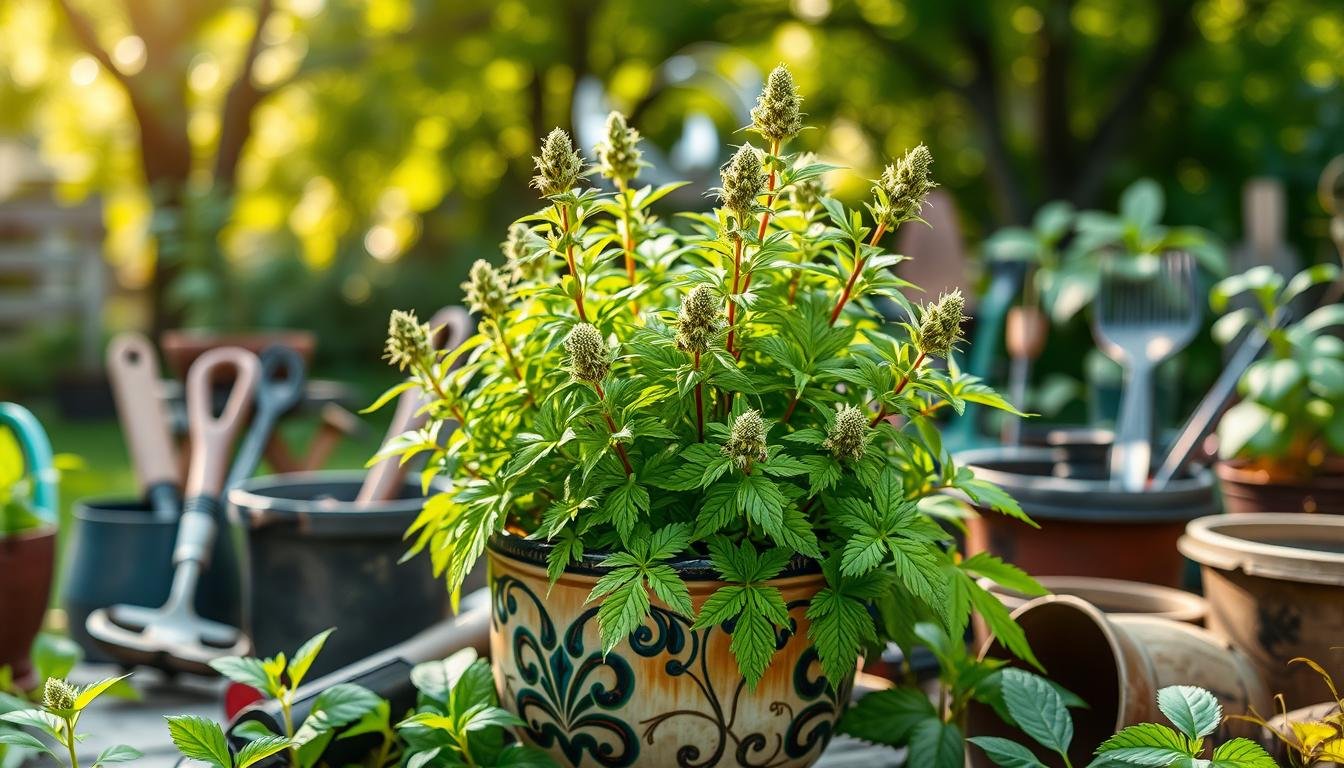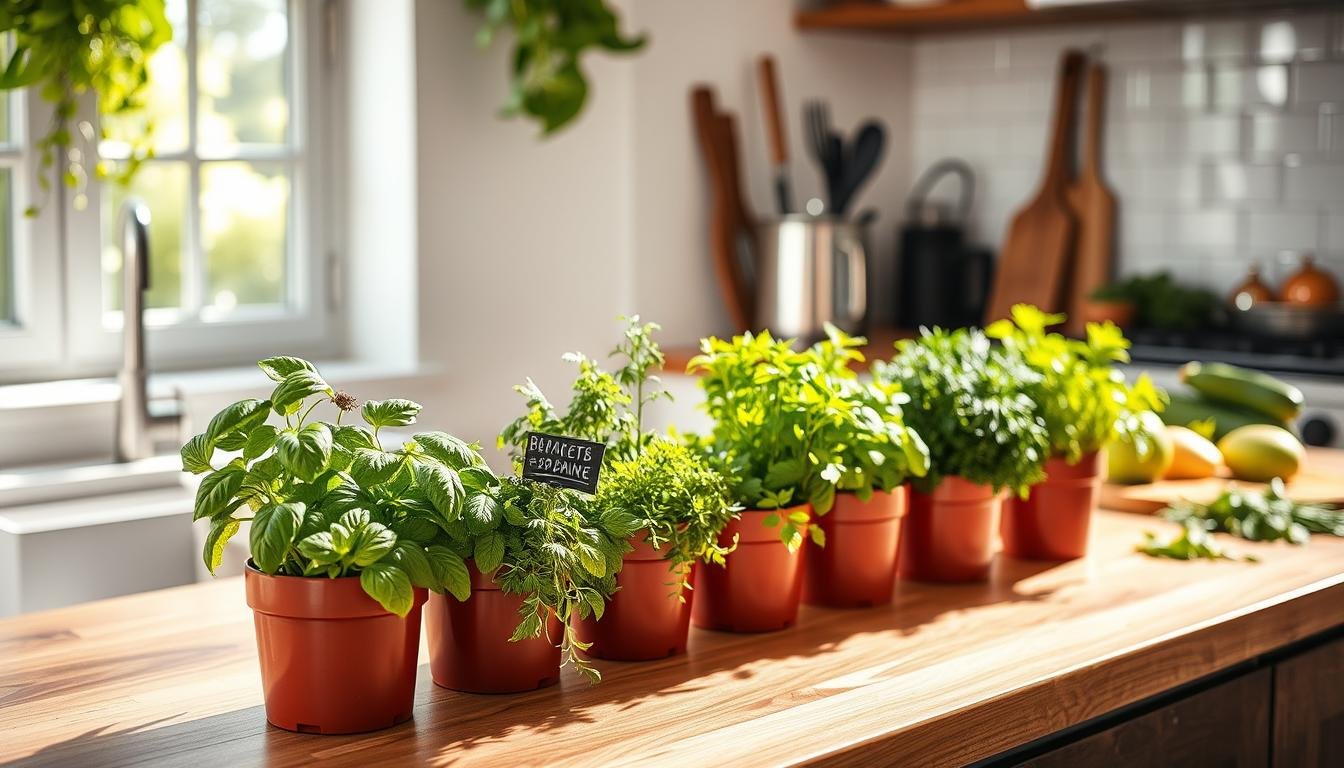About 40% of all food in the US goes to waste. This fact shows why it’s important to grow your own food. Indoor gardening makes it easy to grow food all year, no matter where you live. Be it a city apartment or a country farmhouse.
This guide provides key info on the benefits and methods of growing fresh food daily. You’ll learn about indoor gardening, hydroponics, and greenhouse basics. Discover how you can help the environment and eat healthier from your own garden. Let’s start the exciting journey of growing your own food in every season!
Key Takeaways
- Growing your own food year round helps minimize waste.
- Self-sufficient food production can lead to healthier eating habits.
- Indoor gardening offers solutions for limited space.
- Hydroponics is a viable option for year-round cultivation.
- Greenhouse gardening can enhance crop yields throughout the seasons.
Introduction to Growing Your Own Food
Growing your own food is both useful and rewarding. Gardening has changed from simple gardens to complex systems. These changes let people choose fresher, healthier foods.
Many are starting gardens due to food security worries. It’s more than saving money; it’s about connecting with nature. With little space and new methods, anyone can start gardening.
People have grown their own food for centuries. Now, there’s renewed interest in sustainable living. There are many resources for beginners, such as local services, online guides, and workshops. Starting a garden can lead to a fulfilling lifestyle change.
Benefits of Growing Your Own Food Year Round
Growing your own food all year has many pros, especially for health and saving money. It brings you closer to what you eat and boosts your wellness. Let’s dive into these benefits.
Health Benefits
Home gardening’s health perks are huge. You get to eat fresh fruits and veggies without bad pesticides. This means your meals are more nutritious.
Studies show that home-grown foods often have more antioxidants and vitamins than those from stores. Gardening is good for your body and mind. It keeps you fit and lowers stress.
Economic Advantages
There are big economic benefits to growing your own food. You can save a lot on groceries by growing fruits, vegetables, and herbs yourself. Here’s a breakdown of how much you might save compared to buying from stores.
| Type of Produce | Cost per Pound (Store) | Cost per Pound (Home-Grown) | Annual Savings (Based on 100 lbs/year) |
|---|---|---|---|
| Tomatoes | $3.00 | $1.00 | $200 |
| Carrots | $1.50 | $0.50 | $100 |
| Lettuce | $2.00 | $0.75 | $125 |
| Herbs | $20.00 | $5.00 | $1,500 |
By doing gardening, you can save lots of money and eat healthier. It also makes you more self-reliant and supports a sustainable way of living.

Understanding Indoor Gardening
Indoor gardening lets people grow their own plants, even with little space. It’s key to create the right space for plants to flourish. The amount of light and the right temperature are very important.
Choosing the Right Space
First, find the perfect spot in your home for gardening. Here are things to keep in mind when picking your space:
- Natural Light: Areas with lots of sunlight, like south-facing windows, are best. If sunlight is scarce, consider using grow lights.
- Temperature: Plants do well in temperatures between 65°F and 75°F. Make sure your space stays around these temperatures.
- Maximizing Small Spaces: If you have a small place, use shelves or vertical racks to save space.
Essential Indoor Gardening Tools
The right tools make gardening easier and more successful. Here are some must-have indoor gardening tools:
| Tool | Purpose | Recommended Brand |
|---|---|---|
| Grow Lights | They help plants grow in areas without enough natural light | GE Grow Light |
| Pots | They allow for good drainage and enough room for roots | Plastic or Terracotta Pots |
| Soil Types | Different types support different plant needs | Miracle-Gro Potting Mix |
| Watering Systems | They help keep plants watered just right | HydroFarm Watering Can |
Choosing the right plants and tools is crucial for a thriving indoor garden. With the right setup and care, you can grow an indoor garden in any space.
Year-Round Cultivation Techniques
Growing food all year involves knowing different ways to cultivate plants, like comparing soil gardening to hydroponics. Each method has unique pros and cons. Gardeners need to think about these when choosing how to grow their plants.
Soil vs. Hydroponics
Soil gardening is the age-old way that uses earth for plants to grow in. It doesn’t cost much to start, which is great for many gardeners. On the other hand, hydroponics grows plants in a nutrient-filled water solution. This method lets plants grow faster and produce more.
Hydroponics saves water because it recycles it. It also lets gardeners control the nutrients plants get very precisely. Here’s how the two methods stack up:
| Feature | Soil Gardening | Hydroponics |
|---|---|---|
| Initial Investment | Lower | Higher |
| Maintenance | Moderate | Higher |
| Growth Rate | Slower | Faster |
| Yield | Variable | Higher |
| Water Usage | More | Less |
Best Crops for All Seasons
Picking the right plants for each season is key to gardening all year. You need to choose plants that do well in different weather. For each season, think about growing these:
- Spring: Lettuce, peas, and radishes
- Summer: Tomatoes, cucumbers, and bell peppers
- Fall: Broccoli, carrots, and beets
- Winter: Kale, spinach, and garlic
By growing these crops, gardeners can have fresh veggies all year. It also lets them make the most of soil gardening and hydroponics.
Greenhouse Gardening Essentials
Greenhouse gardening lets you grow plants all year long. It’s important to pick the right greenhouse to make the most of your space and keep your plants healthy. Understanding the different types of greenhouses will help you choose wisely. Think about the size, materials, and features for controlling the climate inside.
Choosing the Right Greenhouse
There are many greenhouses to fit your gardening goals. You can choose from traditional ones that stand alone to ones that connect to your home. Each type has its own benefits:
- Freestanding Greenhouses: These allow for more light and flexibility in where you can place them.
- Attached Greenhouses: These save space and make controlling the temperature easier because they’re connected to your house.
- Hoop Houses: These are an affordable option that works well for small gardens.
Keep in mind certain things when choosing a greenhouse:
- Size: Think about how much room you have and how big you want your garden to be.
- Materials: Decide between glass, plastic, or polycarbonate. Each material has different benefits for insulation and durability.
- Climate Conditions: Look at the weather in your area. This will help you pick the right systems for ventilation and heating.
It’s key to have good ventilation and temperature control in your greenhouse. Keeping the right temperature and humidity levels is essential for strong plant growth. Use these tips to choose your greenhouse and make a perfect home for your plants.
Seasonal Crop Rotation Strategies
Effective seasonal gardening improves soil health and boosts productivity. Understanding crop rotation is crucial for gardeners. It helps prevent nutrient loss and controls pests.
Understanding Seasonal Growing Cycles
Each season offers different opportunities for gardeners. Knowing about these cycles helps pick the best crops. For example, kale and peas do well in spring. But, tomatoes and peppers are best for summer. Here’s a closer look at seasonal crops:
| Season | Crops | Benefits |
|---|---|---|
| Spring | Kale, Peas, Radishes | Rapid growth, nitrogen fixation |
| Summer | Tomatoes, Corn, Bell Peppers | High yield, drought resistance |
| Fall | Spinach, Carrots, Beets | Extended harvest, improved flavor |
| Winter | Garlic, Onions, Cover Crops | Soil nourishment, weed suppression |
Maximizing Plant Yield
To increase garden yield, use different strategies. Intercropping, or growing crops close together, helps pest control and soil use. Companion planting makes plants help each other. Here are some best practices:
- Test soil regularly to check nutrients
- Use organic fertilizers for healthy soil
- Mulch to keep moisture and fight weeds
Using these tips can make your garden flourish. Crop rotation plays a big part in successful gardening.

Home Hydroponics Systems
Home hydroponics systems let you grow plants without soil. This makes gardening inside easy for everyone, even if you’re new. You can choose from different hydroponic systems to suit your needs. Each kind has its own perks and downsides. This way, you can grow food indoors in a way that works best for you.
Types of Hydroponic Systems
There are many hydroponic systems for different growing styles. Here are some common ones:
- Nutrient Film Technique (NFT): This system uses a thin layer of nutrient-packed water over the roots. It’s great for saving water and helps plants get plenty of oxygen.
- Deep Water Culture (DWC): In DWC, plants float in nutrient water with roots under water. Oxygen is provided with air stones, helping plants grow well.
- Aeroponics: Plant roots hang in air and get nutrients from a fine mist. This gives them lots of oxygen and makes them grow fast.
Setup and Maintenance Tips
Setting up a hydroponics system at home can seem hard, but it can be quite simple. Here’s how to get started:
- Pick a hydroponic system that fits your space and the plants you want to grow.
- Collect what you need, like a reservoir, lights, and pumps.
- Put your system together. Make sure everything is secure and works well.
- Keep an eye on nutrient levels, changing them as needed to keep plants healthy.
- Stop algae from growing by covering your reservoir and using the right lights.
Caring for a hydroponic garden takes work but growing your own fresh produce at home is rewarding.
Vertical Farming for Urban Agriculture
Vertical farming is a smart way to garden in cities, where space is tight. It turns walls, balconies, and rooftops into places where plants can grow. Let’s look at how to make the most of small spaces with vertical gardens.
Space-Saving Techniques
For vertical gardening to work well, you need the right strategies. Here’s what you can do:
- Wall Planters: These help plants grow up walls, making them both pretty and practical.
- Stackable Systems: Tiered planters let you plant more in less space, and they’re easy to take care of.
- Hanging Gardens: This approach lets plants hang and grow upwards without using the floor.
- Plant Towers: These towers fit many plants in a tiny area, perfect for city gardens.
Benefits of Vertical Gardening
Vertical gardening is good for gardeners and cities. Here are the main perks:
- Reduced Water Usage: These gardens use drip irrigation, which saves water and keeps plants healthy.
- Lower Carbon Footprint: Growing food locally means fewer trucks on the road, which is better for the planet.
- Enhanced Biodiversity: Vertical gardens are homes for different creatures, adding to city life.
- Improved Air Quality: Plants clean the air, making it fresher for everyone.
- Fresh Produce Accessibility: These gardens let people have fresh fruits and veggies, which is great for health.
Vertical gardening changes unused spaces into fertile spots for urban farming. As cities get bigger, these smart methods will help people be more self-reliant and boost local food supplies.
Controlled Environment Agriculture
Controlled Environment Agriculture (CEA) is changing how we grow food. It controls environmental factors for the best growth conditions. Using technology, it manages temperature, humidity, and light. This makes a perfect place for plants throughout the year. CEA is key because it increases food production, makes growing seasons longer, and fights pests and diseases.
Understanding Climate Control
Climate control is vital in this type of agriculture. Farmers adjust the environment to support different crops. They focus on:
- Temperature Regulation: Keeping the right temperature helps plants grow well.
- Humidity Management: The right humidity level fights disease and helps plants breathe.
- Light Control: Proper lighting, whether natural or artificial, supports photosynthesis.
| Factor | Importance | Methods of Control |
|---|---|---|
| Temperature | Enhances growth rates and yields | Heating/cooling systems, vents |
| Humidity | Reduces disease and boosts growth efficiency | Dehumidifiers, misting systems |
| Light | Essential for photosynthesis | LED lights, reflective surfaces |
By using controlled environment agriculture, we can grow plants in perfect conditions. It’s also a step towards sustainable farming. This method helps us produce quality food. It supports food security in both cities and countryside areas.
Maximizing Space for Self-Sufficient Food Production
To create a self-sufficient garden, you must think about space and resources. Using container gardening and raised beds can achieve excellent results in a small area. Both methods offer unique benefits for different gardening needs.
Utilizing Containers and Raised Beds
Container gardening is perfect for small spaces, like city environments. It brings many benefits of raised bed gardening, such as better drainage, soil quality, and easy access. Consider these materials and plants for your garden:
- Materials for Raised Beds:
- Wood (cedar or redwood is preferred)
- Bricks or stones for looks
- Recycled plastic for lasting use
- Best Plants for Containers:
- Tomatoes
- Herbs (basil, parsley)
- Leafy greens (spinach, lettuce)
Composting and Soil Health
Thriving plants need healthy soil. Composting organic waste makes soil fertile, crucial for good gardening. Learn what materials are best for composting:
- Fruit and vegetable scraps
- Grass clippings
- Dry leaves and straw
Keep your compost pile well-aired and moist. Turning it regularly speeds up decomposition. Test and enrich your soil to boost garden productivity.
| Composting Materials | Benefits |
|---|---|
| Fruit and Vegetable Scraps | Makes your soil richer |
| Grass Clippings | Boosts nitrogen and texture |
| Dry Leaves | Improves air flow and holds moisture |
Combining these methods will help your garden flourish year-round. Both container gardening and effective composting are key for self-sufficiency.
Steps to Start Growing Your Own Food Year Round
Starting your own garden is rewarding. First, plan where it will be. This could be a backyard, balcony, or a windowsill. Check how much sunlight the area gets. Knowing this lets you pick the best crops for your space.
Choose crops that can grow continuously. Leafy greens, herbs, and tomatoes are good for starters. Learn about your local weather. It helps you plan when to plant for the best results.
Getting the right materials is important. Look for quality seeds from local nurseries or online. Using compost can make your soil better. These tips help beginner gardeners start growing their own tasty food.



